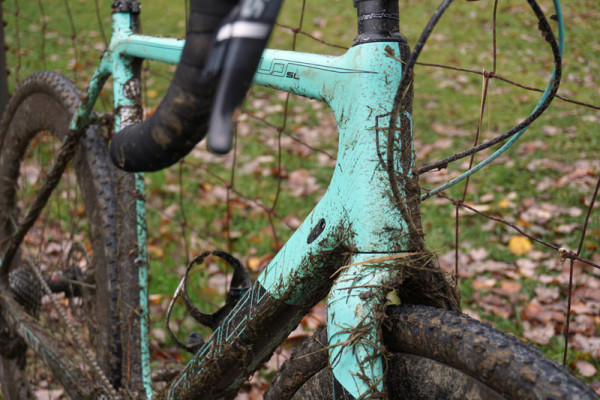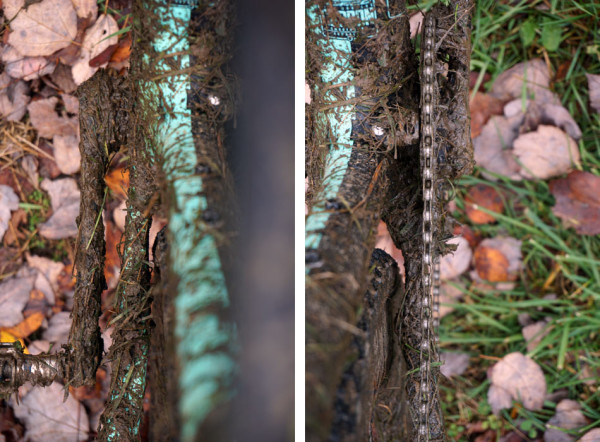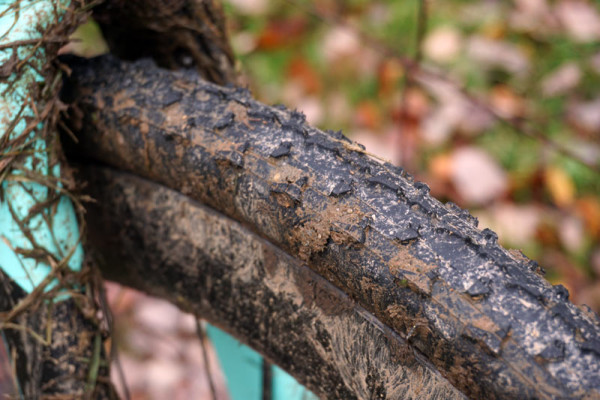With so many cyclocross bikes being built (or marketed, anyway) to handle everything from gravel to adventure, while still being ready come race day, it’s refreshing to see something purpose built. It’s also a very nice excuse to add one more bike to the quiver if you’re really into ‘cross.
The Norco Threshold SL is such a purebred, designed to be wicked fast and quite capable, taking cues from its North Shore hucking brethren in order to blast through the roughest of courses. The frame comes in two flavors, standard “C” with mid-modulus carbon, and the lighter, stiffer “SL” with high modulus fibers on both the frame and fork. I tested the SL CX1, their top model for the 2015/16 season, which should carry over mostly the same for 2016/17 save the likely spec and color changes. Which might actually be a shame, because few bikes garnered as many compliments from spectators and fellow racers than this one, and the spec is mostly superb.
The frame will carry over unchanged for another season, which is fantastic. Because it’s fast. Very fast. And very stiff without beating you up. But, it’s not without its quirks…
The Threshold SL frame and fork use hi-mod fibers throughout and thru axles front and rear. The lower level C version uses the mid-mod fibers and weighs in 150-200g heavier.
The frame is kept tidy (aesthetically, anyway) by internal ports for both shifting and the rear brake. The ports are covered when not in use, as on this 1x setup. The front brake’s hose runs externally and uses a small clip bolted to the inside of the crown to keep it away from the tire. That clip was missing from the box when it arrived, so a zip tie made do until a replacement arrived. While the clip’s bolt hole looks like it places the hose directly between it and the tire, reducing clearance, the actual slot for the cable sits just out front of the fork, so it didn’t catch any undue mud.
Underneath, a larger port aids rear brake/derailleur line installation and then acts as the front derailleur’s guide. Yes, that’s a fender mount, but no, I wouldn’t recommend turning this bike into a commuter.
Any extra metal was left off, with only a threaded insert on the drive side.
The complete bike, with tubes, came in at 17.48lb (7.93kg) out of the box. The bar tape is included but not installed, letting you choose which side you want the green and black to go. With 2015 Crank Brothers Candy 3 pedals installed, the rideable weight was 18.10lb (8.21kg).
The bike comes with Clement Crusade PDX 700×33 tires, for which there is plenty of clearance front and rear.
35’s would likely fit, the narrowest section being between the chainstays.
The tapered headtube and big, rectangular downtube create a massively stiff power transfer section leading into the oversized chainstays. Nothing’s lost here.
Aiding power transfer are Rotor’s ovalized Q-rings and ultra-rigid alloy crank arms. By improving your leverage where you’re strongest, they’re perfect for a power-intensive sport like ‘cross.
A bolt-on chain catcher prevents the chain from dropping to the inside. Despite bunny hops, rapid fire roots and the conditions that led to this mud and grass clipping monster of a clean up, I never dropped a chain.
Thankfully, there’s no shelf at the chainstay bridge to catch muck.
SRAM’s CX1 group maintained solid shifting and braking through it all, including rides just below freezing.
These pics were taken after my first race, which also happened to be my first real ride on the bike. To which I showed up just before the start, allowing for only one warmup/recon lap. On which I slid out and landed on the driveside and bent the derailleur hanger just enough to make the shifting a little hesitant. Thankfully it still worked, and Norco sent a replacement hanger along with the front brake hose clip.
160mm rotor up front, 140mm in the back. Disc brakes FTW. Case closed.
While the deep carbon wheels are up for debate based on personal preferences, the tires were really the only thing that was hit or miss. On this day, they missed. Clement bills the Crusade PDX as their “Portland” tire, good for mud and wet conditions. I beg to differ, unless Portland, OR, has some very, very different mud than the east coast. Our clay turns to a peanut-butter-and-Crisco mix that laughs at the very notion of traction, and these suffered for it…in the wet mud.
But, at my second race on the bike, it was dry with lots of grass and some hardpack clay, and they shined. Horses for courses, as they say.
The cockpit uses an Easton EA70 alloy stem and EC70SL carbon handlebar, and a Norco carbon seatpost.The Fizik Tundra rounds it out and was a smart choice for it’s textured cover material. Regardless of wet or dry, the non-slip texture prevented unwanted sliding around over bouncy terrain.
Retail price is $5,125USD. The SL frameset is $1,875, and other models range from $2,095 (C frame, 105 group) to $3,775 (SL frame, Ultegra 2×11).
RIDE REVIEW
The Norco Threshold SL CX1 is a race bike. Everything about it is fast and efficient at the expense of versatility and creature comforts. That’s not to say it’s harsh -it does have manners- but it gives up small bump compliance for all out speed.
The geometry helps, too. It’s an interesting spread, with a shorter effective top tube length than a size 58 frame would imply. It measures to 572mm, where most bikes I’m riding in this size are closer to 585mm. Jump to the 60.5 frame size and ETT only goes to 600mm. So, it came down to wanting the right seat tube length, thus the 58 for my test. And it was the right choice.
Couple the short TT with short chainstays (425mm) and a steeper head angle (72.5º), and you also get a short wheelbase (1029mm). Put it all together and you end up with a bike that handles quickly, dodging other riders in a 60+ person mass start and whipping through triple-S course tape chicanes without dropping speed.
Straight line stability is fine, too, somehow. Its weak spot was high speed broad, swooping turns. I think it was a combination of lack of confidence in the tires combined with the shorter, steeper geo, but it took more concentration and front loading to keep it steady on the sweepers.
In fact, I ended up sliding the saddle forward a bit more to help keep my weight over the front end more, which helped improve the handling. I like that position anyway, it feels more powerful to me, but I’m looking well over the handlebar to the front axle. Lest there be any remaining doubt: Quick race bike.
I asked about the wheel selection, and Norco’s product manager Logan Johns said “We chose the deep carbon rim because of its mud shedding capabilities and added stiffness. Also, because they look so badass!”
Fair enough. The 3t Discus Team C60’s do look bad ass. And they sliced through the deep mud easily.
They’re also very stiff, which is both good and bad. Good in that they handle predictably and hold their line. Bad in that they transmit more bumps through to the rider. That’s amplified by higher pressures I had to run to prevent pinch flats.
Which brings me to this: It really needs to go tubeless. By some magic of 3T’s curved rim design or Clement’s sidewall layering, I didn’t pinch flat, but it wasn’t for lack of trying. Even at 42-44psi, I nailed some roots hard and fast enough to feel the rim impact. Numerous times, both in racing and training/riding. I kept waiting for that hissssssss to ruin my ride, but it never came.
Even so, the lower pressures I could run with tubeless would go a long way to smoothing out the ride just enough. And shallower rims would amplify that benefit, along with being lighter and spooling up quicker…something that’s very important in the hammer, brake, hammer, brake rhythm that is cyclocross.
Lastly, the aerodynamics of the wheels might have been tested with road tires, but with 33mm knobbies, there’s a lot of sideways pushing in crosswinds.
I had my best race of the season on this bike. Once I had my position dialed, we flowed like water through the course. If I were keeping it, I’d set up different tires on these rims for muddy races and have a lighter, shallower tubeless set for dry days, but otherwise it’s a very well thought out grass crit machine. Did I mention it’s fast?
























